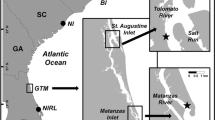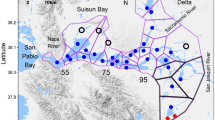Abstract
Vertical and horizontal distributions of 3 larval stages of the oyster Crassostrea virginica were measured concurrently with phytoplankton species compositions, phytoplankton size distributions and physical hydrographic parameters in tributaries of the Chesapeake Bay (USA) during the oyster spawning seasons of 1980 and 1981. The superposition of the biological distributions upon the physical hydrographic data provide instantaneous distributions of the entire system which are consistent with the upstream transport of oyster larvae. Oyster larvae distributions in the Choptank River and its Broad Creek and Tred Avon River tributaries can be described in terms of three contiguous regions: (1) a common spawning region, (2) an intermediate, upstream transport region and (3) a seed bed region where major spat set occurs. The phytoplankton species compositions and abundances in the size fraction less than 10 μm in the tributary system during the transport were sufficient to supply optimum growth requirements of developing larvae. The transport proposed can explain the 30 yr record of consistently higher spat set success in one tributary, Broad Creek, relative to an adjoining tributary, the Tred Avon River. This may be a general mechanism whereby oysters maintain reproductive success and emigrate to seed bed regions in the Chesapeake Bay.
Similar content being viewed by others
Literature Cited
Carriker, M. R.: Ecological observations on the distribution of oyster larvae in New Jersey estuaries. Ecol. Monogr. 21, 19–38 (1951)
Chanley, P. and J. D. Andrews: Aids for identification of bivalve larvae of Virginia. Malacologia 11, 45–119 (1971)
Chesapeake Bay Institute: St. Mary's River Cruise, 19 June–18 July 1952. Data Rep. Chesapeake Bay Inst. 11 (1952)
Cronin, W. B. and R. C. Seitz: Some slack temperature and salinity distributions in vertical sections along the longitudinal axis and across the entrance of Chesapeake Bay, April 1969–July 1974. Chesapeake Bay Institute 1975. (Graphical Summary No. 7)
Davis, H. C. and R. R. Guillard. Relative value of ten genera of micro-organisms as foods for oyster and clam larvae. Fishery Bull. Fish Wildl. Serv. U.S. 58, 293–304 (1958)
Galstoff, P. S.: The American oyster Crassostrea virginica Gmelin. Fishery. Bull. Fish Wildl. Serv. U.S. 64, 1–480 (1964)
Loosanoff, V. L. and C. A. Nomejko: Spawning and setting of the American oyster, O. virginica, in relation to lunar phases. Ecology 32, 113–134 (1951)
Manning, J. H. and H. H. Whaley: Distribution of oyster larvae and spat in relation to some environmental factors in a tidal estuary. Proc. natn. Shellfish. Ass. 45, 56–65 (1954)
Meritt, D. W.: Oyster spat set on natural culch in the Maryland portion of the Chesapeake Bay (1939–1975). Spec. Rep. Univ. Med Cent. envir. estuar. Stud. 7, 1–30 (1977)
Nelson, J.: Report of the biologist. Rep. New Jers. St. agric. exp. Stn June, 1910 183–218 (1911)
Pritchard, D. W.: The physical hydrography of estuaries and some applications to biological problems. Trans. N. Am. Wildl. Conf. 16, 368–376 (1951)
Pritchard, D. W.: Distribution of oyster larvae in relation to hydrographic conditions. Proc. Gulf Caribb. Fish. Inst. Nov. 1952 1–10 (1952)
Rogers, H. M.: Occurrence and retention of plankton within the estuary. J. Fish. Res. Bd Can. 5, 164–171 (1940)
Seliger, H. H. and M. E. Loftus: Growth and dissipation of phytoplankton in Chesapeake Bay. II. A statistical analysis of phytoplankton standing crops in the Rhode and West Rivers and an adjacent section of the Chesapeake Bay. Chesapeake Sci. 15, 185–204 (1974)
Seliger, H. H., M. E. Loftus and D. V. Subbarao: Dinoflagellate accumulations in Chesapeake Bay. Proc. 1st int. Conf. tox. Dinoflagellate Blooms, 181–205 (1975). (Ed. by V. R. LoCicero. Wakefield, Mass.: Massachusetts Science and Technology Foundation)
Seliger, H. H., K. R. McKinley, W. H. Biggley, R. B. Rivkin and K. R. H. Aspden: Phytoplankton patchiness and frontal regions. Mar. Biol. 61, 119–131 (1981)
Taft, J. L., W. R. Taylor, E. O. Hartwig and R. Loftus: Seasonal oxygen depletion in Chesapeake Bay. Estuaries (Solomons, Md), 3, 242–247 (1980)
Tyler, M. A. and H. H. Seliger: Annual subsurface transport of a red tide dinoflagellate to its bloom area. Water circulation patterns and organism distributions in the Chesapeake Bay. Limnol. Oceanogr. 23, 227–246 (1978)
Tyler, M. A. and H. H. Seliger: Selection for a red tide organism. Physiological responses to the physical environment. Limnol. Oceanogr. 26, 310–324 (1981)
Wallace, D. H.: Sexual development of croaker, Micropogon undulatus, and distribution of the early stages in Chesapeake Bay. Trans. Am. Fish. Soc. 70, 475–482 (1940)
Wood, L. and W. J. Hargis: Transport of bivalve larve in a tidal estuary. Proc. 4th Eur. mar. Biol. Symp. 29–44 (1971). (Ed. by D. J. Crisp. Cambridge: Cambridge University Press)
Author information
Authors and Affiliations
Additional information
Communicated by N.D. Holland, La Jolla
Contribution No. 1144 of the McCollum-Pratt Institute and Department of Biology
Rights and permissions
About this article
Cite this article
Seliger, H.H., Boggs, J.A., Rivkin, R.B. et al. The transport of oyster larvae in an estuary. Mar. Biol. 71, 57–72 (1982). https://doi.org/10.1007/BF00396993
Accepted:
Issue Date:
DOI: https://doi.org/10.1007/BF00396993




